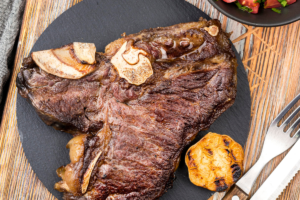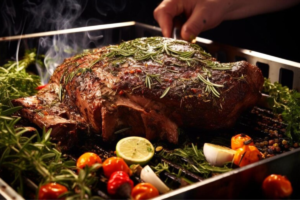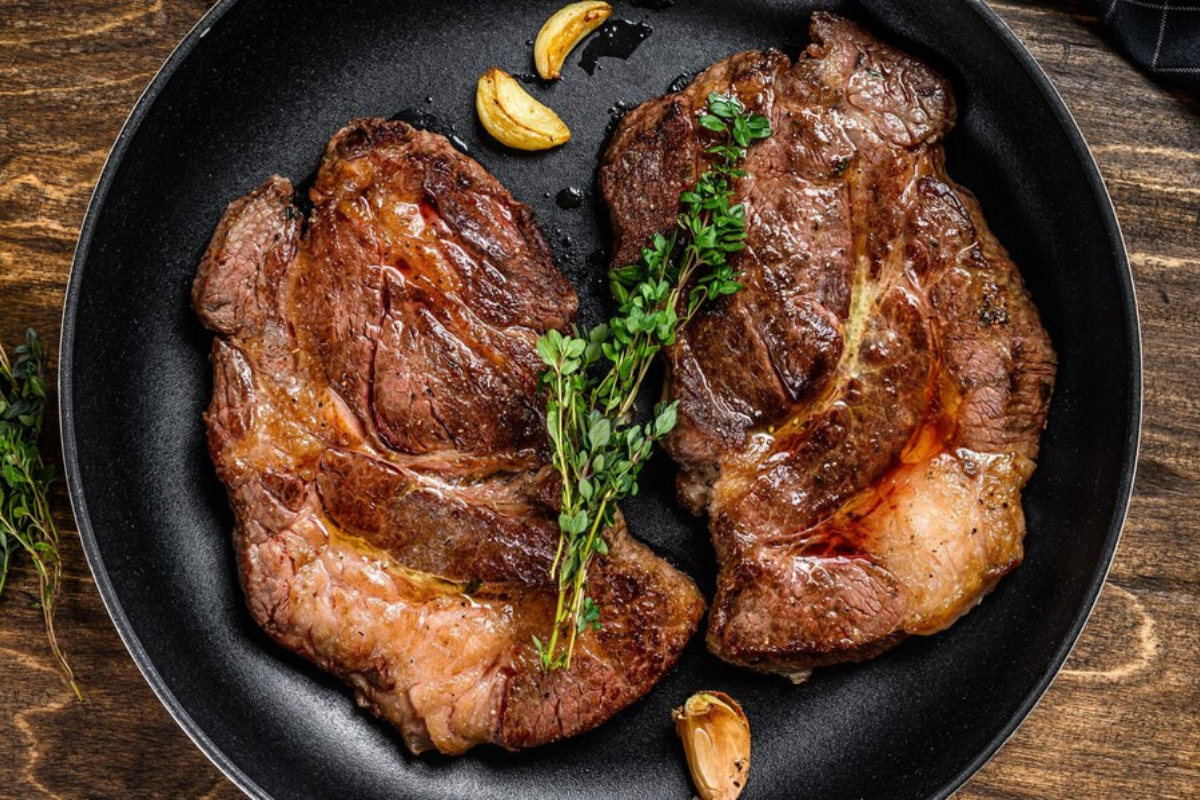In the world of beef, some cuts stand out more than others. The ribeye, tenderloin, and sirloin often take center stage due to their tenderness and flavor. However, other cuts offer rich taste and versatility, making them indispensable in the kitchen. One such cut is the chuck roast. But is chuck roast good to eat? This comprehensive guide explores everything you need to know about chuck roast its flavor, nutritional value, cooking methods, health benefits, and more. By the end, you’ll know whether chuck roast deserves a spot on your dining table.
What is Chuck Roast?
Before diving into whether chuck roast is good to eat, it’s essential to understand exactly what it is. Chuck roast comes from the shoulder area of the cow, a region known as the “chuck.” This area includes various muscles, which results in tougher meat due to extensive muscle use during the cow’s life. However, this toughness also means that the chuck roast is incredibly flavorful.
- Location: The chuck lies between the neck and the rib of the cow, including a portion of the shoulder blade and extending into the upper arm. Understanding this positioning helps explain the characteristics of chuck roast it’s a cut that has done a lot of work, resulting in both toughness and deep flavor.
- Cut Variety: The chuck section can be divided into various cuts, including the chuck eye roast, shoulder roast, and cross-rib roast. Each has unique attributes, but all share the common feature of being from the chuck region.
The History of Chuck Roast
Historically, chuck roast has been a staple in various cuisines, particularly in those that value slow-cooked, hearty meals. In the United States, chuck roast gained popularity during the 19th and 20th centuries as a key ingredient in pot roast—a dish synonymous with Sunday family dinners. The affordability and flavor of chuck roast made it a go-to for families looking to feed a large group without breaking the bank.
Globally, the chuck section has been used in various traditional dishes. In France, it is often used in boeuf bourguignon, a slow-cooked beef stew made with red wine, onions, and mushrooms. In Mexico, chuck roast is commonly used in barbacoa, a slow-cooked meat dish that is tender, flavorful, and often served with tortillas.
Nutritional Value of Chuck Roast

When it comes to nutrition, chuck roast offers a range of essential nutrients that contribute to a balanced diet. Let’s break down the key nutritional components of chuck roast:
Calories and Protein Content
A 3-ounce serving of chuck roast typically contains around 200-250 calories, depending on the specific cut and preparation. This moderate-calorie option is ideal for those monitoring their intake. Additionally, chuck roast is rich in protein, providing about 20-25 grams per serving. Protein is crucial for muscle growth, repair, and overall bodily functions.
Fat Content and Essential Nutrients
The fat content in chuck roast can vary, but it generally contains about 12-15 grams of fat per serving, with around 5-6 grams of that being saturated fat. Fat is essential for various bodily functions, including hormone production and energy storage. The marbling (intramuscular fat) in chuck roast enhances its rich flavor, particularly when slow-cooked. Additionally, chuck roast is a good source of essential vitamins and minerals, including iron, zinc, and B vitamins like niacin, riboflavin, and vitamin B12. These nutrients play critical roles in energy production, immune function, and the maintenance of healthy blood cells.
For a more in-depth look at the nutritional benefits of red meat, including beef like chuck roast, you might want to explore this Harvard School of Public Health resource.
The Flavor Profile and Texture of Chuck Roast
People enjoy chuck roast primarily because of its rich flavor. The chuck section of the cow contains well-marbled meat, with a good amount of fat interspersed throughout. This marbling enhances the robust taste of chuck roast, especially when cooked in a way that allows the fat to render and infuse the meat with flavor.
Taste and Texture
The flavor of chuck roast is often described as deep and beefy, with a slightly sweet undertone due to the marbling. The slow cooking process, which is typically used for chuck roast, allows the flavors to develop fully, resulting in a dish that is savory and satisfying. The texture of chuck roast can vary depending on how it’s cooked. When prepared using slow-cooking methods like braising or slow roasting, chuck roast becomes incredibly tender, almost falling apart with a fork. This tenderness results from the breakdown of collagen and connective tissue in the meat, which requires time and low heat to achieve.
If you’re interested in learning more about the science behind braising and how it affects the flavor and texture of meat like chuck roast, you can explore this comprehensive guide on how to braise meat.
Cooking Methods

Given its toughness, chuck roast benefits most from cooking methods that involve low and slow heat. These methods allow the connective tissues to break down, resulting in tender, flavorful meat. Here are some of the most effective ways to cook chuck roast:
1. Slow Cooking
Slow cooking is one of the most popular ways to prepare chuck roast. This method involves cooking the meat at a low temperature for an extended period, usually in a slow cooker or crockpot. The slow cooking process allows the flavors to meld together and the meat to become incredibly tender. It’s also a convenient method, as you can set it up in the morning and have a delicious meal ready by dinnertime. A classic pot roast is the perfect example of a slow-cooked chuck roast dish. Combine the chuck roast with potatoes, carrots, onions, and a flavorful broth, and let it cook on low for 8-10 hours.
2. Braising
Braising is another excellent way to cook chuck roast. It involves first searing the meat on all sides in a hot pan to develop a flavorful crust, then cooking it slowly in a liquid such as broth, wine, or a combination of both at a low temperature. Braising not only tenderizes the meat but also infuses it with the flavors of the braising liquid. This method is ideal for creating dishes with rich, complex flavors. Consider making a braised beef chuck roast with red wine and herbs. Sear the roast, then simmer it slowly in a Dutch oven with red wine, beef broth, garlic, and fresh herbs like rosemary and thyme.
3. Roasting
Roasting chuck roast is less common than braising or slow cooking, but you can achieve excellent results when you do it correctly. It requires a slightly higher temperature than braising and usually involves cooking the meat uncovered in the oven. It allows the exterior of the chuck roast to develop a crisp, caramelized crust, which adds a delightful texture contrast to the tender interior. For a roasted chuck roast, try seasoning the meat with a simple rub of salt, pepper, garlic, and rosemary, then roast it at a low temperature (around 275°F) for several hours until the internal temperature reaches the desired doneness.
The Pros and Cons of Eating Chuck Roast
Like any food, chuck roast has its pros and cons. Understanding these can help you decide if it’s the right choice for your diet and culinary needs.
Pros:
- The rich, beefy taste of chuck roast is one of its biggest selling points. The marbling and connective tissues, when cooked slowly, provide a depth of flavor that is hard to match.
- Chuck roast is typically less expensive than other cuts of beef, such as ribeye or tenderloin. This makes it a great option for those looking to enjoy beef without spending too much.
- You can use chuck roast in a variety of dishes, ranging from classic pot roasts to tacos, stews, and more. Many people love it because of its versatility in the kitchen.
- Chuck roast packs essential nutrients like protein, iron, and B vitamins, which are crucial for maintaining good health.
Cons:
- While the marbling in chuck roast contributes to its flavor, it also means that this cut is higher in fat, including saturated fat. For those who are watching their fat intake, this might be a concern.
- Unlike more tender cuts of beef, chuck roast needs to be cooked slowly to become tender. This can be a drawback if you’re looking for a quick meal.
- If not cooked properly, chuck roast can be tough and chewy. It requires some culinary know-how to get it right, which might be intimidating for beginners.
Is Chuck Roast a Healthy Choice to eat?
When evaluating whether chuck roast is a healthy choice to eat, it’s essential to consider both its nutritional benefits and potential drawbacks.
Health Benefits:
- As a rich source of protein, chuck roast can support muscle growth and repair, making it a good option for those who are physically active or looking to build muscle mass.
- Iron is crucial for producing hemoglobin, the protein in red blood cells that carries oxygen throughout the body. The body absorbs heme iron from chuck roast more easily than non-heme iron found in plant-based foods.
- Chuck roast contains several B vitamins, including niacin, riboflavin, and vitamin B12. These vitamins play essential roles in energy production, brain function, and maintaining healthy skin and nerves.
Potential Health Risks:
- While chuck roast does provide beneficial fats, it is also relatively high in saturated fat. Diets high in saturated fat can contribute to an increased risk of heart disease. However, it’s important to note that recent studies have suggested that the link between saturated fat and heart disease is more complex than previously thought, and that consuming saturated fat in moderation may not be as harmful as once believed.
- Chuck roast is relatively calorie-dense due to its fat content. For those watching their calorie intake, portion control is key when enjoying this cut of beef.
Incorporating chuck roast into a balanced diet is possible, particularly when paired with nutrient-dense foods like vegetables and whole grains. By doing so, you can enjoy the flavor and nutritional benefits of chuck roast while maintaining a healthy diet.
Eat Chuck Roast Recipes for a Balanced Diet
Given its rich flavor and versatility, chuck roast can be an excellent addition to a balanced diet when prepared and served thoughtfully. Here are some ideas for incorporating chuck roast into your meals:
1. Pot Roast with Root Vegetables
A classic pot roast is perhaps the most well-known dish made with chuck roast. To make it a balanced meal, include a variety of root vegetables like carrots, potatoes, and parsnips. These vegetables add not only flavor but also important nutrients like fiber, vitamins, and minerals. When making pot roast, consider using low-sodium broth to control the salt content. You can also trim some of the fat from the chuck roast before cooking to reduce the overall fat content of the dish.
2. Chuck Roast Tacos
For a twist on traditional tacos, try using shredded chuck roast as the filling. Slow-cook the roast with spices like cumin, chili powder, and garlic, then shred it and serve with corn tortillas, avocado, salsa, and a squeeze of lime. To keep this meal balanced, add a side of black beans and a fresh salad with plenty of greens. The beans provide fiber and additional protein, while the salad adds a refreshing contrast to the rich meat.
3. Beef and Vegetable Stew
A hearty beef stew made with chuck roast and an assortment of vegetables can be a comforting and nutritious meal. Include colorful vegetables like bell peppers, zucchini, and tomatoes. Serve the stew over barley or brown rice. Season with a mix of fresh and dried herbs, and add a splash of red wine for depth of flavor. The alcohol will cook off during the simmering process, leaving behind a rich taste.
4. Braised Chuck Roast with Mushrooms
Mushrooms pair wonderfully with the rich flavor of chuck roast. For this dish, braise the chuck roast with mushrooms, onions, and garlic in a mixture of beef broth . Serve the braised beef over mashed cauliflower for a lower-carb option. To increase the fiber content of this meal, consider adding a side of roasted Brussels sprouts or a simple green salad with a light vinaigrette.
FAQs
Many people have questions about chuck roast, particularly when it comes to its health benefits and how best to cook it. Here are some of the most frequently asked questions:
- Is chuck roast good to eat for weight loss?
Chuck roast can fit into a weight loss diet if portion sizes are controlled and it’s prepared with vegetables using low-fat cooking methods. - Can you eat chuck roast every day?
While chuck roast is nutritious, it’s best enjoyed as part of a varied diet that includes a range of protein sources. Eating a variety of meats, fish, and plant-based proteins ensures you get a broad spectrum of nutrients. - What is the best way to cook chuck roast for maximum tenderness?
Slow cooking or braising at a low temperature helps achieve tender meat. These methods break down the connective tissues, creating a melt-in-your-mouth texture. - How does chuck roast compare to other cuts of beef?
Chuck roast is more flavorful and affordable than some other cuts but requires longer cooking times to become tender. While it’s not as tender as cuts like ribeye or filet mignon, it offers a depth of flavor that many find superior. - Is chuck roast good for meal prep?
Yes, chuck roast is excellent for meal prep because it can be cooked in large batches and stored for several days. Dishes like pot roast, beef stew, and shredded beef tacos can be made ahead of time and reheated as needed.
Conclusion
So, is chuck roast good to eat? Absolutely. This cut of beef offers robust flavor, nutritional benefits, and versatility, making it a great addition to any kitchen. Though it requires time and effort to cook properly, the result is worth it. Whether in a classic pot roast, braised with mushrooms, or shredded for tacos, chuck roast delivers a hearty meal. Incorporate it into a balanced diet and explore different cooking methods to enjoy all its benefits while maintaining a healthy lifestyle.


1 thought on “Is chuck roast good to eat ?”